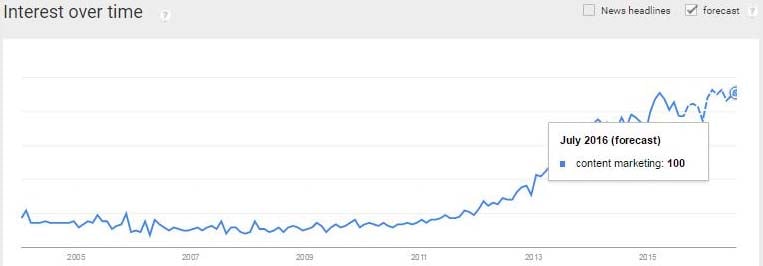
Discover 8 Social Media Mistakes That Singapore Marketers Commit!
July 10, 2015
Discover How To Optimize Your YouTube Videos And Generate Maximum Views
July 18, 2015
The screenshot you see above is captured from Google Trends. “Content Marketing” as a key phrase has been on an upward trend since 2011. Today, it is widely practiced around the world and is gaining popularity. We expect B2B marketers will continuously and actively adopt content marketing in 2016.
According to Demand Metric, 90% of organizations, by marketing with content, are spending 62% less than what they do with traditional marketing, and that’s certainly good news. Here are several other encouraging content marketing trends:
1. Personalized content play a bigger role.
Publishing and distribution tools now theoretically make anyone a mass publisher. And in a world where content multiplies exponentially and time remains finite, it’s harder to be remarkable. Marketers want users to interact with their content, and what better way to achieve that than through providing something relevant?
That’s why many companies are designing personalized content. Content personalization takes a variety of forms, all of which come down to audience segmentation. Typically, marketers can pare down how they segment the audience through categories like Location, Interest, Behavior, Referral. Segmentation provides the opportunity to gain an extremely granular understanding of customers, then to anticipate their needs, wants, affinities, and expectations and develop unique insights to power better marketing across all devices, channels, localities, and brand experiences.
Your customers’ data will be instrumental to how you can begin to publish and deliver more personalized content to them at the right time.
2. Increase engagement impact of content marketing with visual storytelling.
Due to the increase in marketing noise, marketers will need to find a medium that will help their message stand out from the crowd and that could be visual storytelling. Visual storytelling is best used to communicate a brand’s philosophy and aesthetics. In April 2014, Starbucks had a contest asking patrons to draw on their Starbucks cups, take a photo, and then enter the contest with #WhiteCupContest on social media. 4,300 entries later, Starbucks had created a nice buzz that played out on social media, all while connecting personally to their audience.
According to TheVerge.com, 8 of the top 10 most shared posts on Facebook incorporate video. Also, 93% of the most engaging Facebook posts include images. This shows that visual stories crafted for marketing purposes can spark a movement or inspire emotions, sending a clear message about the brand to its consumers and helping to define it against the surrounding surge of noise.
3. LinkedIn dominates industry and marketing news.

According 2014 B2B Content Marketing Trends, 91% of B2B Marketers used LinkedIn to distribute content, and 62% of them rate LinkedIn as an effective social media platform. As Business Insider reported, LinkedIn plans to be a $1 billion business by 2017, by becoming “the most effective online platform for marketers to engage with professionals.” LinkedIn is set to become a dominant social channel for content distribution.
4. Location-Based Content Marketing will provide huge ROI.
With more people owning smartphones and checking in to location-based services, the possibility of reaching a meaningful swath of consumers and more importantly, knowing where they are during the day is becoming a reality. Location-based couponing and promotions are continuing to drive in-store visits and sales.
One example of how brick-and-mortar businesses are using location-based marketing to increase ROI is the use of geo-aware marketing in a campaign launched earlier this year by Meguiar’s (an auto-care products company). By showing relevant ads in areas that showed a high volume of car and car-accessory buyers, the company was able to achieve a $1.31 ROI and a 118% increase in sales in exposed markets. The main aim of native ads is to entertain and enlighten the viewers without explicitly promoting a particular product or service. These ads often talk about topics that are in some way related to the product or service the company is offering.
According to Cisco, location-based mobile advertising accounts for $4.5 billion this year; and this number is expected to rise to over $10 billion by 2017. We can see more and more firms will increasingly conduct location-based content marketing.
5. Businesses will look for ways to automate their content marketing, and these efforts will fail.
With businesses creating and promoting more content than ever, it’s no surprise they would be looking for ways to streamline and automate the process. The popularity of marketing automation would rise in order to keep pace.
However, many argue that automating content isn’t without its problems; unrealistic expectations of what marketing automation can accomplish may be one of the biggest hurdles.
According to HubSpot, a leading content marketing automation provider, content marketing is not a “once and done” proposition: “Marketing automation needs constant care and awareness for it to work effectively. Too many companies skimp on these details and think they can let their automation do all the work—not exactly the best way of accomplishing your goals.”
It is easy to be remarkable once. The trick is being remarkable consistently. The one-size-fits-all approach will not work in the world of marketing. Use these trends to your advantage to develop the best strategies that work for you.
{{cta(‘d54cc04e-3cdc-4b79-845c-bc391be70411’)}}


